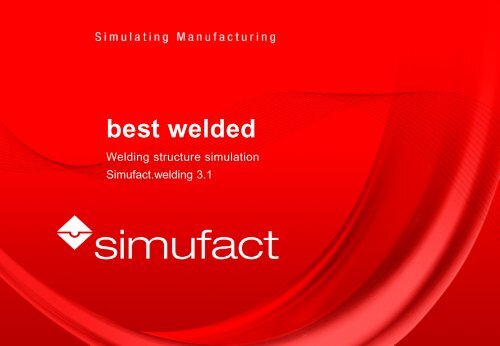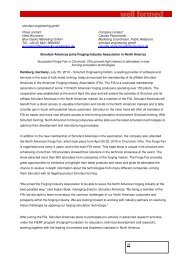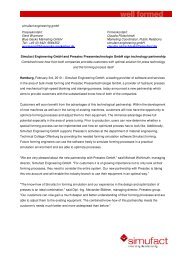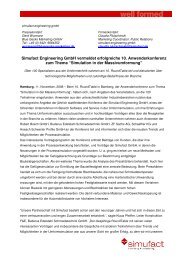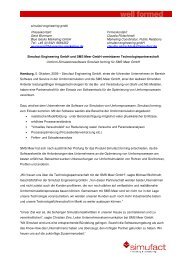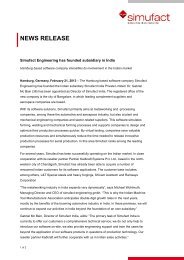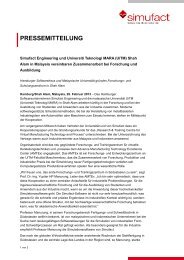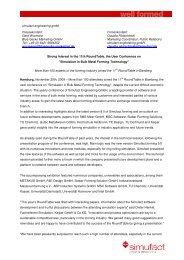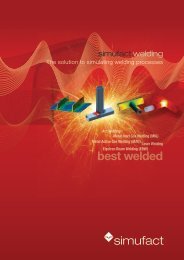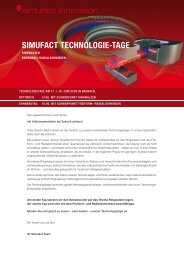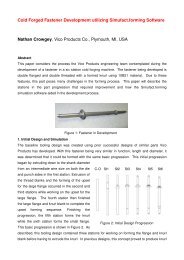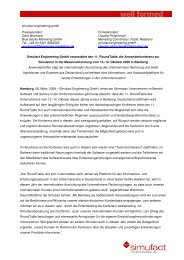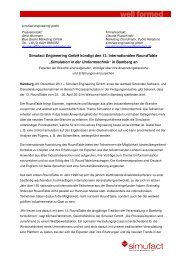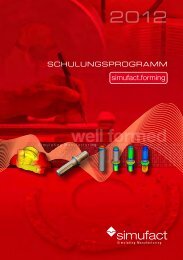product presentation simufact.welding
product presentation simufact.welding
product presentation simufact.welding
You also want an ePaper? Increase the reach of your titles
YUMPU automatically turns print PDFs into web optimized ePapers that Google loves.
est welded<br />
Welding structure simulation<br />
Simufact.<strong>welding</strong> 3.1
What is Simufact.<strong>welding</strong>?<br />
Simufact.<strong>welding</strong><br />
Slide 2<br />
Virtual process design<br />
Temperature distribution in components and heat<br />
transfer into clampings<br />
Prediction of <strong>welding</strong> distortions and<br />
residual stress during <strong>welding</strong> and after<br />
releasing tools<br />
Simulation of local material properties<br />
(e.g. flow stresses or phase fractions)<br />
Graphical <strong>presentation</strong> and export<br />
of tracking points<br />
Simulation of process chain and<br />
further mechanical analysis<br />
Simufact.<strong>welding</strong> is directed to <strong>welding</strong><br />
specialists in research, development and<br />
manufacturing.<br />
There is no need to be a specialist for<br />
computer aided calculation methods.
What can Simufact.<strong>welding</strong> offer?<br />
Virtual process design of <strong>welding</strong> processes including tacking, fixing concept and<br />
pre-heating<br />
Simufact.<strong>welding</strong><br />
Slide 3
What can Simufact.<strong>welding</strong> offer?<br />
Virtual process design of <strong>welding</strong> processes including tacking, fixing concept and<br />
pre-heating<br />
Simufact.<strong>welding</strong><br />
Slide 4
What can Simufact.<strong>welding</strong> offer?<br />
Temperature distribution in components and heat transfer into clamping tools<br />
Simufact.<strong>welding</strong><br />
Slide 5
What can Simufact.<strong>welding</strong> offer?<br />
Prediction of distortions during and after clamping and prediction of residual<br />
stresses due to <strong>welding</strong><br />
Simufact.<strong>welding</strong><br />
Slide 6
What can Simufact.<strong>welding</strong> offer?<br />
Fast process variations by copy function<br />
For instance minimization of distortions via varying the clamping conditions<br />
Simufact.<strong>welding</strong><br />
Slide 7
What can Simufact.<strong>welding</strong> offer?<br />
Automatical real simulation of possible gap formation during <strong>welding</strong> by high<br />
resolution contact between components<br />
Simufact.<strong>welding</strong><br />
Slide 8<br />
F ?<br />
F ?<br />
Gap ?<br />
F ?<br />
F ?
What can Simufact.<strong>welding</strong> offer?<br />
Simulation of local material properties e.g. changed flow stresses of phase<br />
fractions<br />
Simufact.<strong>welding</strong><br />
Slide 9
What can Simufact.<strong>welding</strong> offer?<br />
Graphical <strong>presentation</strong> and export of tracking points<br />
Simufact.<strong>welding</strong><br />
Slide 10
How does Simufact.<strong>welding</strong> works?<br />
Simufact.<strong>welding</strong><br />
Slide 11<br />
Geometry and meshing<br />
Weld paths and fillermaterial<br />
Mechanical and thermal boundary<br />
conditions<br />
Heat source modeling<br />
Time management<br />
Prediction of local material properties<br />
Postprocessing
Geometry and meshing<br />
• Finite element meshes can be imported from a Nastran-bulk-file (*.bdf)<br />
• Automatic mesh refinement during <strong>welding</strong> for high thermal gradients<br />
Simufact.<strong>welding</strong><br />
Slide 12
Weldpath and fillermaterial<br />
• Easy definition of weld paths via node picking or by import of a csv-file<br />
with path coordinates<br />
• Automatic generation of a FE-mesh for filler material<br />
Simufact.<strong>welding</strong><br />
Slide 13
Mechanical boundary conditions<br />
• Automatic generation of clamping geometries<br />
• Adjustable clamping times<br />
Simufact.<strong>welding</strong><br />
Slide 14<br />
Contact between components<br />
and filler materials<br />
Contact between components and tools:<br />
Spring stiffness C:<br />
Automatic determination of the direction<br />
rectangular to the contact surface<br />
Initial force F:<br />
Automatic determination of the<br />
direction rectangular to the contact<br />
surface
Therma boundary conditions<br />
• Automatic detection of free surfaces for heat dissipation<br />
• Heat flux definition on contact surfaces<br />
• Variable initial temperature for preheated work pieces<br />
• Predefined default values<br />
Initial work-piece<br />
temperature<br />
Simufact.<strong>welding</strong><br />
Slide 15<br />
Convection:<br />
Q c = -h A (T 1 - T 2)<br />
Heat transfer via surface contact and<br />
heat transfer coeffient<br />
Q CHT = α A (T 1 - T 2)<br />
Emissions coeffizient ε:<br />
Stefan-Boltzmann-equation:<br />
Q E = -ε A (T 1 4 - T2 4 )<br />
(0 ≤ ε ≤ 1)
Heat source models<br />
• Positioning and rotation of heat sources<br />
• Automatic projection on surface with offset function<br />
Simufact.<strong>welding</strong><br />
Slide 16
Heat source models<br />
Simufact.<strong>welding</strong><br />
Slide 17<br />
Combination of heat sources using offset function
Time management<br />
Simufact.<strong>welding</strong><br />
Slide 18
Material modeling during <strong>welding</strong><br />
Simufact.<strong>welding</strong> includes <strong>simufact</strong>.premap modules (Nancy model)<br />
Interface to JMatPro etc.<br />
Simufact.<strong>welding</strong><br />
Slide 19<br />
austenite<br />
Austenite<br />
während during<br />
Schweißen<br />
<strong>welding</strong><br />
Martensit<br />
nach<br />
Abkühlen<br />
martensite<br />
after cooling
Postprocessing<br />
Simufact.<strong>welding</strong><br />
Slide 20
Three-point bending tests<br />
Process chain <strong>welding</strong> – forming / acc. plastic strains as an indicator for damage<br />
Temperature distribution during <strong>welding</strong><br />
Acc. plastic strains during <strong>welding</strong><br />
Simufact.<strong>welding</strong><br />
Slide 21<br />
Acc. plastic strains during forming<br />
Highest level of<br />
accumulated<br />
plastic strains at<br />
the weld seam<br />
close to forming<br />
tools
Deep drawing and <strong>welding</strong><br />
Residual stress after <strong>welding</strong><br />
Without forming results With forming results<br />
Accumulated plastic strains after <strong>welding</strong><br />
Simufact.<strong>welding</strong><br />
Slide 22<br />
Lifting distortion of the cover on<br />
the opposite edge<br />
Calculated without forming results<br />
Calculated with forming results<br />
• After <strong>welding</strong> the component is highly plastically deformed and under high residual<br />
stresses which influence the stress distribution and distortions during and after <strong>welding</strong>
Welding and deep drawing<br />
Simufact.<strong>welding</strong><br />
Slide 23<br />
Implementation of <strong>welding</strong> distortions into forming analysis<br />
Temperature distribution during <strong>welding</strong><br />
Acc. plastic strains during <strong>welding</strong><br />
Model: Forming of tailored blanks<br />
accumulated plastic strains after forming
Deep drawing and <strong>welding</strong><br />
Implementation of plastic strains and residual stresses for into <strong>welding</strong> analysis<br />
• Forming simulation including unclamping, cooling, trimming and positioning for <strong>welding</strong> can be<br />
performed in <strong>simufact</strong>.forming<br />
• Import of formed geometry from arc-files<br />
• Import of forming results from arc-files via introducing a “pre state” block in the dat-file (in<br />
<strong>simufact</strong>.<strong>welding</strong> 3.1.0 by hand)<br />
Simufact.<strong>welding</strong><br />
Slide 24<br />
Right mouse click Import geometries
Calculation quality<br />
• Determination of residual stresses are said to be a quality proof for structural<br />
weld analysis<br />
• International Round Robin test (IIW) is used as a reference example (German<br />
standart DIN SPEC 32534-1: Numerical <strong>welding</strong> simulation — Execution and documentation)<br />
• 2-Layer TIG weld<br />
material 316LNSPH / 316L<br />
voltage 9 V<br />
current 155 A<br />
<strong>welding</strong> velocity 40,2 mm/min<br />
Simufact.<strong>welding</strong><br />
Slide 25<br />
distortion angle<br />
measurement: 0.033°<br />
simulation: 0.032°
Conclusion<br />
• Welding simulation can be user-friendly. Simufact.<strong>welding</strong><br />
offers:<br />
Simufact.<strong>welding</strong><br />
Slide 26<br />
a.) an automatic mesh refinement<br />
b.) handles incompatible meshes<br />
c.) offers a fillet generator for FE-Meshes<br />
d.) a fast method to define weld paths and<br />
process orientation<br />
e.) heat source models and interfaces to<br />
process simulations<br />
f.) modeling of clamping tools<br />
• A fast virtual optimization of clamping conditions, tacking is<br />
possible<br />
• A coupling of <strong>simufact</strong>.<strong>welding</strong> and <strong>simufact</strong>.premap allows a<br />
prediction of the phase proportions during and after <strong>welding</strong><br />
• A coupling of <strong>simufact</strong>.<strong>welding</strong> and <strong>simufact</strong>.forming allows<br />
process-chain modeling
<strong>simufact</strong> engineering gmbh<br />
Tempowerkring 3<br />
21079 Hamburg<br />
Tel.: 040-790 162-0<br />
Fax: 040-790 162-22<br />
office@<strong>simufact</strong>.de<br />
www.<strong>simufact</strong>.de


